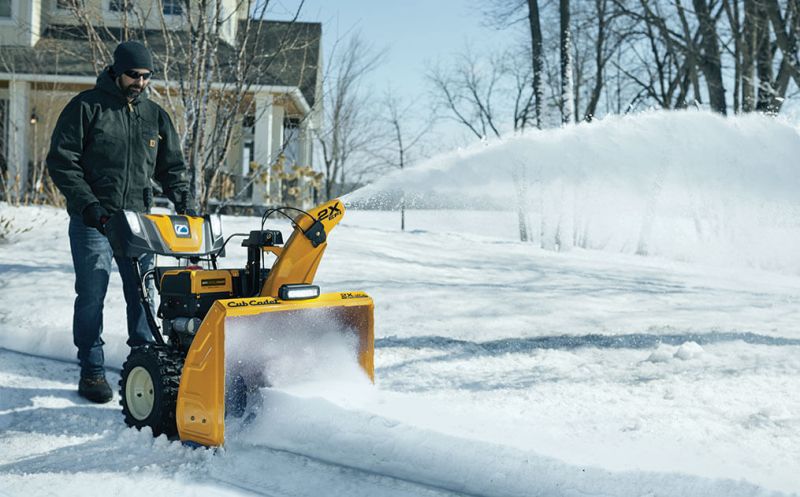A snow blower or a snow thrower is one of those power tools that come with a whole lot of overwhelming features. If you’re buying one for the first time, or after a long time, going through the multiple features in a bid to find those that suit your needs can be a tad overwhelming.
Secondly, to those newcomers that know nothing about snow blowers, there are many technical terms you’re likely to hear most of which are confusing. So, to help you out, this post has narrowed down these features to only focus on those parameters that will directly suit your needs.
1. Your Purpose

The first thing you need to consider when buying a snow blower is your purpose. What are you planning to do with it? The reason why this is important is that these power tools come in three main stages that are namely 1st stage, 2nd stage, and 3rd stage.
The single-stage blowers are mostly small and are used to clear snow in medium-sized areas. These types of snow blowers have single augers that propel snow through a discharge chute and are best in clearing snow with a depth of 6 inches.
Two-stage and three-stage snow blowers are larger hence the best for clearing snow in wide areas ranging from 60 ft. long. They’re equipped with engine-driven wheels and are either gas or electric-powered.
2. Power Source
Other than the snowblower stages, another factor that demands serious consideration is the source of power. Are you looking for a gas-powered model or are you comfortable with an electric model? Electric models come in either corded or cordless variations.
Corded models are less noisy and have zero emissions. However, to use them, you’ll need to have a long extension cord that will be about 100 ft. long.
Cordless models, on the other hand, act as a crossbreed between corded and gas-powered snow blowers. They’re less noisy, have zero emissions, and offer more freedom of mobility.
Lastly, we have the gas-powered models. These ones rely on very powerful engines that allow them to clear wider areas of snow with depths of up to 20”. They offer better mobility than corded models and are more powerful than battery-powered models.
3. Used or New Snow Blower
Buying a new snowblower, especially the best snow blower under 500 can save you a lot. But, what if your budget is way off this range? Well, in such a case, considering a used snowblower can seem to be the only way out.
Although it’s a good Plan B option, it’s also risky if you’re not aware of what to look for. So, if you’ve decided to buy a used snowblower, you need to check the following. One, ensure that the spare parts are easy to find.
Two, inspect the cables and the switches to ensure there’s no loose connection. Three, double-check the auger and the impeller to ensure they’re in perfect condition. If you can, conduct a test drive to ensure everything is working perfectly.

4. Think about the Size
When it comes to the size, what we’re basically referring to here is the size of your pathway, walkway, or driveway. For instance, a typical homeowner with a small driveway of around 18”-22” will benefit from a single-stage snowblower, as it’s smaller hence the best for clearing snow in profile spaces.
However, if you have a large multi-car driveway, a single-stage snowblower won’t help as much as it will take a longer time to clear snow from a large area. For that reason, a two-stage or three-stage blower will be the best pick as it’s larger and more powerful to clear broader paths.
5. Be the Early Bird
When buying a snowblower, you need to be very keen on your timing. In most cases, shopping early, especially in late September and early October, comes with many sweet rewards such as discounted deals. During this time, most merchants sell their products at cheaper prices to clear their inventory.
Secondly, shopping early gives you ample time to ask questions, as there are fewer customers. This helps you to get a quality snow blower that will suit all your needs.
6. Are There any Extra Features?
Lastly, are there any extra features you’d like to see in your snowblower besides its usual duties? If that’s the case, then here are some useful extra features you’d like to check out.
- Dead Man Control: This useful feature turns off the auger and the impeller when you release the handle.
- Power Steering: This is a useful feature that lets you maneuver your snow thrower quickly and effortlessly.
- Push Start Button: This convenient feature lets you start an electric snow thrower with the push of a button.
- Long Handle: A long handle is a great necessity that allows you to adjust the height of the snow thrower.
- Headlights: In case of an emergency, a pair of headlights will help you work after dark.
- Multi-Speed: More speed gears mean that you’ll manage to clear the toughest snow without getting stuck.
Conclusion
So, there you have it. As you can see, choosing a snowblower is not just a walk in the park. There are many factors that demand serious consideration. Thankfully, this guide has discussed some of the key parameters you have to consider.
So, to avoid making the wrong decision, always stay in line with what you need. Whether it’s a single-stage blower or a two-stage/three-stage blower, this post has offered you everything you need to know when making your decision.






